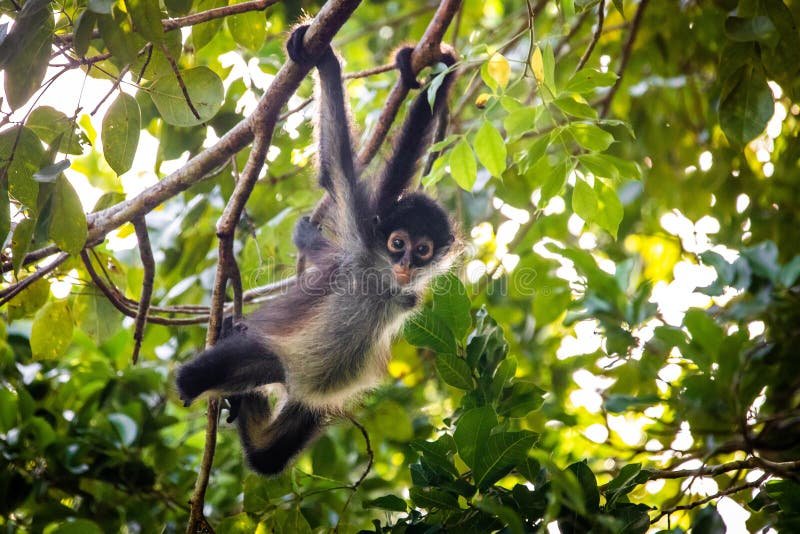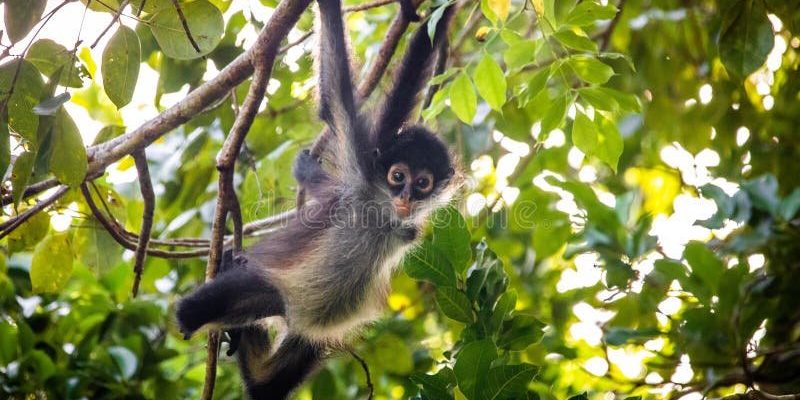
Spider monkeys, with their long limbs and prehensile tails, showcase parenting strategies that are both unique and efficient. Watching them is like observing a well-rehearsed dance—there’s a rhythm to how they interact, how they care for their young, and how they communicate. So, how exactly do spider monkeys raise their young in the wild? Let’s explore this captivating aspect of their social behavior.
The Role of the Troop in Child Rearing
In spider monkey communities, the troop plays a crucial role in raising young ones. These troops are typically made up of a few adult females and several males, often forming a matriarchal structure. The females usually stay with their birth troop for life, while males tend to leave to find their own groups.
When it comes to raising their young, the females take center stage. Mother spider monkeys are incredibly nurturing. They carry their infants on their bellies using their tails for balance, allowing them to navigate through the treetops safely. You might say that the mother’s tail acts like an extra hand, holding tightly to branches while securely cradling the baby.
Interestingly, other troop members also pitch in to help, especially when the young are learning to explore. This shared parenting behavior ensures that the infants receive attention and care from multiple adults, helping them develop social skills and bonds—not just with their mothers but with the entire troop.
The Importance of Play in Learning
Play is essential in the development of spider monkey infants. You might wonder why play is so important. Well, it’s the monkey equivalent of going to school! Through play, young spider monkeys learn vital life skills they will need as adults. They practice climbing and swinging among the branches, developing their muscles and coordination.
These playful interactions also help them understand their social environment. When they wrestle with peers or mimic adult behaviors, they pick up on cues for social hierarchy and group dynamics. Imagine a group of kids playing tag, where they not only have fun but also learn how to communicate, share, and solve conflicts. Similarly, spider monkey infants use play to establish relationships and learn the rules of their community.
As they engage in these playful activities, you’ll often see the mothers watching closely, ready to jump in if things get a bit too rough. This vigilant oversight is like a safety net, ensuring that the young ones learn in a safe environment while developing their independence.
Nourishing Their Young: Feeding Strategies
Feeding is another critical aspect of how spider monkeys raise their young. As herbivores, they primarily eat fruits, leaves, and flowers. Mothers instill good eating habits in their offspring by sharing meals and guiding them to nutritious sources. Initially, infants rely on their mother’s milk, but around six months old, they start to nibble on solid foods.
Here’s where it gets interesting: mother spider monkeys will often check the ripeness of fruits and introduce their babies to various food sources. It’s a bit like taking your child grocery shopping and teaching them about healthy choices. Once the young monkeys grow older, they learn to forage for food on their own, gathering the skills necessary for survival.
Interestingly, they also learn about seasonal food availability through their mothers. It’s not just about filling their bellies; it’s about understanding their ecosystem, which will help them thrive in the wild.
Communication and Bonding
Spider monkeys have a rich palette of vocalizations and body language that they use to communicate. Mothers and infants develop strong bonds through close physical contact, grooming, and vocal exchanges. These interactions promote feelings of safety and affection, which are essential for healthy development.
Infants often vocalize when they’re hungry or seeking attention, and mothers have a unique way of responding to their calls. This communication helps strengthen their bond and ensures that the young ones feel secure. It’s a bit like how we learn to express ourselves and seek comfort from our parents.
As they grow, spider monkey juveniles begin to mimic adult calls and gestures, enhancing their communication skills. The more they participate in troop chatter, the more integrated they become within their community, learning the nuances of social interaction.
Challenges Faced by Spider Monkey Mothers
Raising young spider monkeys is not without its challenges. Predators loom in the shadows of their forest homes, and mothers must be ever-vigilant to protect their infants. Whether it’s hawks swooping down or large cats lurking below, the threat to their little ones can be daunting.
Moreover, habitat loss due to deforestation poses another significant challenge. As their natural habitat shrinks, spider monkey troops become more fragmented. This situation means mothers might have fewer resources and social support to raise their young. You can think of it like trying to raise kids in a crowded city where playgrounds are disappearing; it becomes increasingly tough to foster a safe and nurturing environment.
To combat these challenges, mother spider monkeys often become incredibly resourceful, adapting their parenting strategies based on the environment and circumstances they face.
The Future of Spider Monkey Parenting
With the ongoing threats to their habitat, the future of spider monkey parenting hangs in the balance. Conservation efforts are crucial to ensure that these fascinating creatures can continue their intricate child-rearing practices in the wild. Protecting their environment means more than just saving a species; it’s about preserving the rich tapestry of behaviors and social structures that spider monkeys exemplify.
Educating local communities about the importance of spider monkeys can help foster a sense of stewardship. When people understand how vital these creatures are to the ecosystem—and how closely their parenting methods mirror our own—they may be more inclined to protect their habitats.
Here’s the thing: conserving spider monkeys isn’t just about the animals; it’s about maintaining the biodiversity that benefits us all. By supporting initiatives that promote habitat protection and sustainable practices, we can contribute to a future where these incredible primates can thrive and continue raising their young in the wild.
In conclusion, spider monkeys showcase a beautiful blend of nurturing, community, and adaptability in their parenting. They remind us that raising young—whether in the wild or in our homes—requires support, learning through play, and a strong bond of communication. By understanding how spider monkeys raise their young, we not only deepen our appreciation for them but also get a glimpse into the intricate web of life in the wild.

